Why does Naval say: ZCash is insurance for bitcoin privacy?
Investors speculate that, with the "suspense" of high inflation gone, ZEC may follow a trajectory similar to early Bitcoin.
Original Title: "Why does Naval say: ZCash is insurance for Bitcoin privacy?"
Original Author: Max Wong, IOSG Venture
Note from Rhythm: On October 1, well-known Silicon Valley angel investor Naval Ravikant posted, "Bitcoin is insurance against fiat currency. ZCash is insurance against Bitcoin." Naval is a renowned angel investor in Silicon Valley, having invested in well-known tech companies such as Twitter and Uber. He is also a successful entrepreneur, founder of the equity crowdfunding platform AngelList, and author of the famous book "The Almanack of Naval Ravikant." In the past two months, Zcash ($ZEC) has soared from $40 to $460, an increase of over 1000%. The following is the original content:
Introduction
In the past few months, Zcash ($ZEC) has become the focus of attention. Within 30 days in September 2025, Zcash rose from $47 to $292, an increase of up to 620%. It has now reached its highest price in 8 years at $429, bringing its FDV to over $8 billions.
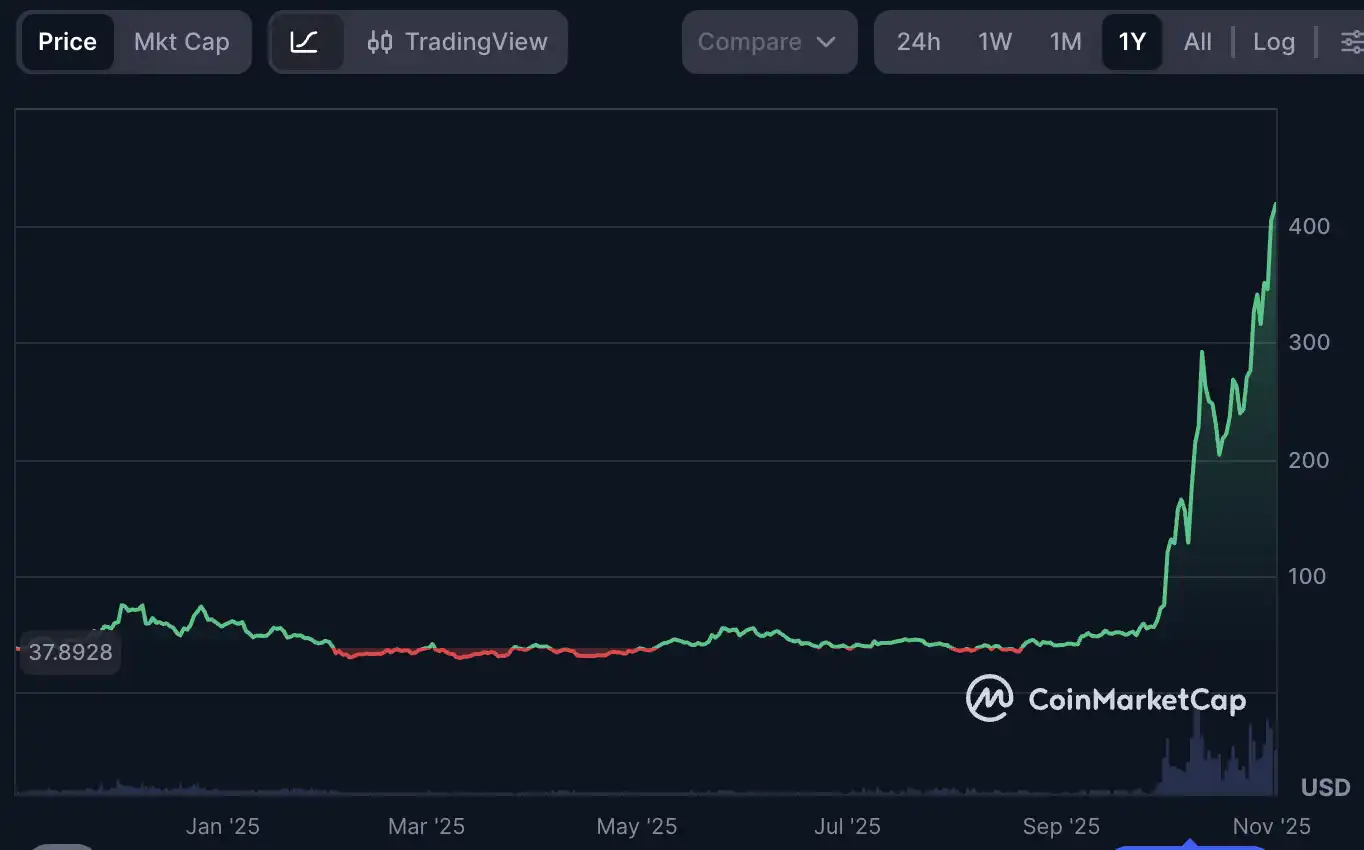
In an era of increasingly strict financial regulation, privacy-focused projects have once again become the focus of the crypto world. Therefore, Zcash (ZEC), as one of the pioneers of privacy coins, has regained interest. This wave has reignited interest in "free money," a term often used to describe private, censorship-resistant digital cash. As a leading privacy coin, Zcash brings true financial privacy through cryptography, expanding on Bitcoin's vision.
This report aims to delve into Zcash's technology and infrastructure, compare it with other privacy players, and analyze the catalysts behind the recent resurgence of the Zcash ecosystem.
Zcash - What is it, and how does it work?
Zcash is a privacy-protecting digital currency launched in October 2016 as a fork of the Bitcoin codebase. It deliberately copies many of Bitcoin's monetary principles; Zcash runs on a proof-of-work blockchain,
and also features the following:
· Fixed Supply: 21 million cap and predictable halving schedule.
· Fair Emission: No premine, Bitcoin-like issuance model.
· Decentralization: Permissionless, no central authority, no reliance on intermediaries.
Privacy Standards
ZCash uses zk-SNARKs (Zero-Knowledge Succinct Non-Interactive Arguments of Knowledge), which allow transactions to be verified without revealing any details about the sender, receiver, or amount. Simply put, Zcash offers users fully encrypted transactions, shielding on-chain data—something Bitcoin's transparent ledger cannot achieve. In fact, this ZK privacy mechanism was something Satoshi Nakamoto wanted to explore for Bitcoin, but it was technically unfeasible at the time.
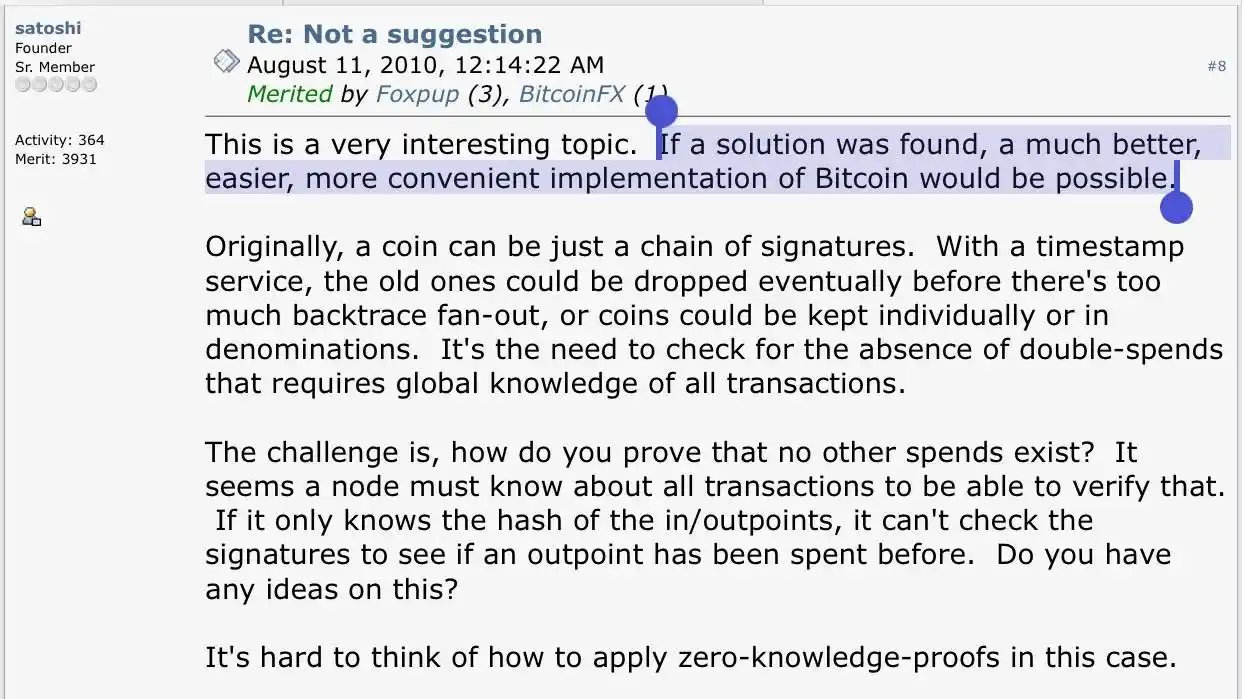
# Encryption of Transaction Details
When users make shielded transactions, key details such as sender address, receiver address, and transaction amount are fully encrypted on-chain.
# Creation of ZK Proof
The sender (prover) uses their private key to generate a zk proof (zk-SNARK), confirming several conditions are met, all without leaking sensitive data:
· The sender has enough funds to pay for the transaction.
· The spent funds were legitimately generated in previous transactions.
· The input value equals the output value, preventing counterfeit coins.
· The sender has the right to use the funds (owns the correct private key).
· The funds have not been previously spent (using a mechanism called "nullifier").
# Instant Verification
Other nodes (verifiers) on the Zcash network use a public verification key to instantly verify the zk-SNARK proof. The proof is very small (a few hundred bytes) and can be verified in just a few milliseconds, making the verification process highly efficient.
Dual Transaction Types
It is worth noting that Zcash's privacy is optional—users can remain transparent for compliance or audit needs, or choose full confidentiality at their discretion.
ZEC uses a dual address system, including transparent addresses (t addresses) and shielded addresses (z addresses). Transactions between transparent addresses are similar to those on any non-private chain, but transactions involving shielded addresses are encrypted and private. When sending ZEC, the ledger does not display any information about the parties or value, only that a valid transaction occurred. Only participants (and those with whom they share optional viewing keys) can see the details.
This gives Zcash fungibility (each unit is interchangeable), unaffected by past history, thus achieving true financial confidentiality when using shielded transactions.
Three Main Pools
Implementing private transactions at scale is a major technical challenge. Zcash has undergone three major upgrade iterations to improve its cryptography and efficiency:
#Sprout (2016)
--The initial release--proved that zk-SNARK-based privacy is feasible on a public blockchain. However, Sprout transactions were computationally heavy (requiring several gigabytes of RAM, not feasible on mobile devices) and required a trusted setup (one-time parameter generation). Edward Snowden, among others, participated under the pseudonym "John Dobbertin" in this famous setup, intended to ensure no party could compromise the parameters. Traditional Sprout z addresses (usually zc...). Now deprecated but still usable.
#Sapling (2018)
--A major upgrade that greatly improved performance and usability. Sapling reduced proof time and memory requirements by more than 100x, finally making private ZEC transactions feasible on everyday devices (even smartphones). It also introduced important features such as diversified addresses (allowing one key to have multiple shielded addresses for greater privacy) and viewing keys (enabling users to share read access to their transaction details for audit or compliance). Sapling still relied on a multi-party trusted setup, but it was a big step toward practical private payments. Sapling z addresses (Bech32, zs......) are still supported, so users can use legacy tokens.
#Orchard (2022)
--The latest generation, achieving trustless privacy. Orchard uses the Halo 2 proof system (developed by Zcash engineers), requiring no new trusted setup. It further improves efficiency, supports batch transactions, and improved synchronization. With Orchard, Zcash's privacy is not only stronger (no setup assumptions) but also more scalable—it is designed to support future second-layer solutions such as ZK-rollups. It also introduces Unified Addresses (UA, u1......), which can bundle receivers from Orchard (and optionally Sapling + Transparent) into one address; wallets typically default to routing new funds to Orchard. Therefore, Orchard is now the default shielded pool for modern Zcash wallets.
A common summary of Zcash's development: Sprout proved the possibility of private funds, Sapling made it usable, and Orchard made it trustless and scalable.
Upcoming Upgrades
Crosslink: Zcash's technical infrastructure is constantly evolving. The project is currently undergoing a major upgrade called Crosslink, which will introduce a hybrid Proof-of-Stake (PoS) layer on top of the Proof-of-Work consensus. This will allow ZEC holders to stake their coins for rewards and participate in block finalization, while miners still produce blocks—combining the advantages of PoW and PoS. This hybrid approach is expected to improve network throughput and security (by providing fast finality and making 51% attacks more difficult).
Tachyon Project: Zcash developers (notably cryptographer Sean Bowe) are leading the implementation of the Tachyon project—which aims to greatly improve the scalability of Zcash's shielded protocol. The goal of the Tachyon project is to eliminate performance bottlenecks (such as every wallet having to download and scan every coin) through innovations like proof-carrying data, enabling "planetary-scale" private payments.
ZCash vs. Monero
Zcash (ZEC) positions itself as a Bitcoin-like currency but with optional encrypted privacy. Its shielded transfers use zk-SNARKs, so verifiers can check transaction correctness without seeing the sender, receiver, or amount. With UA, wallets can send funds to the correct recipient while maintaining auditability: users can still transact transparently or share viewing keys with accountants/regulators. The trade-off is user choice; privacy is strongest when you actually use the shielded pool.
Monero (XMR) uses a different toolkit, providing default privacy in every transaction: ring signatures (mixing the real transaction among many decoys so observers can't tell which wallet actually sent the funds), RingCT (hiding amounts), and stealth addresses (the recipient receives payment via a one-time stealth address that can't be linked back to their real wallet). This makes usage simple, but privacy is probabilistic: its strength depends on ring size (e.g., 16), decoy selection, and user behavior. In practice, its privacy is high, but there is no selective disclosure for audits, and some venues avoid listing it due to compliance friction.
Generally: ring signatures anonymize transactions by placing them among multiple decoys (Monero arguably just increases plausible deniability), while zk-SNARKs prove the truth of a statement without revealing anything except the validity of the statement itself. Initial hesitation about ZCash stemmed from the need for a trusted setup, but with the recent Halo upgrade, ZCash can now generate zero-knowledge recursive proof compositions without a trusted setup. Despite challenges, Monero has been shown to have some traceability in the paper "Monero Traceability Heuristics": "Wallet app bugs and Mordinal-P2Pool perspectives."
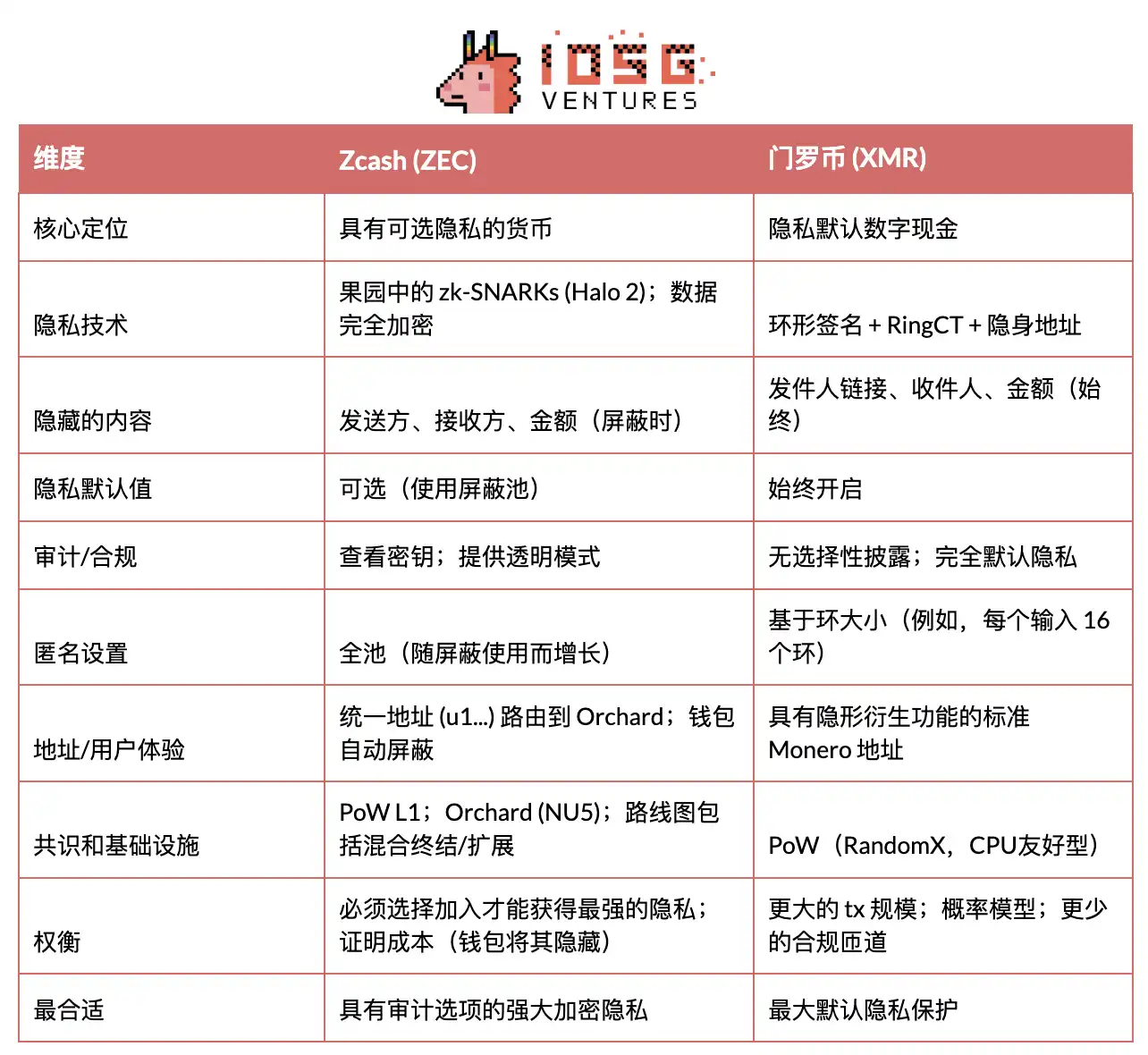
So, why did the market choose ZCash?
What happened?
In the past two months, from early September to now, $ZEC has been on a non-stop upward trend, rising from a low of ~$40 to ~$429, an increase of over 1000%. So, what catalyzed this surge? What are the reasons?
Introduction of Zashi
One of the biggest contributors to ZCash's recent growth is ECC's (Electric Coin Co's) focus on consumers. Previously, the protocol mainly focused on ZCash core—building cryptography and technology—but now, they are more focused on user experience and onboarding. A large part of this effort is the development of Zashi, the official ZCash wallet.
Josh Swihart—ECC CEO:
"When I became ECC CEO in February 2024, we decided to really focus on user experience... We built a wallet called Zashi. After Zashi launched, you can see the total number of shielded transactions and the amount of ZEC in the shielded pool grow exponentially.
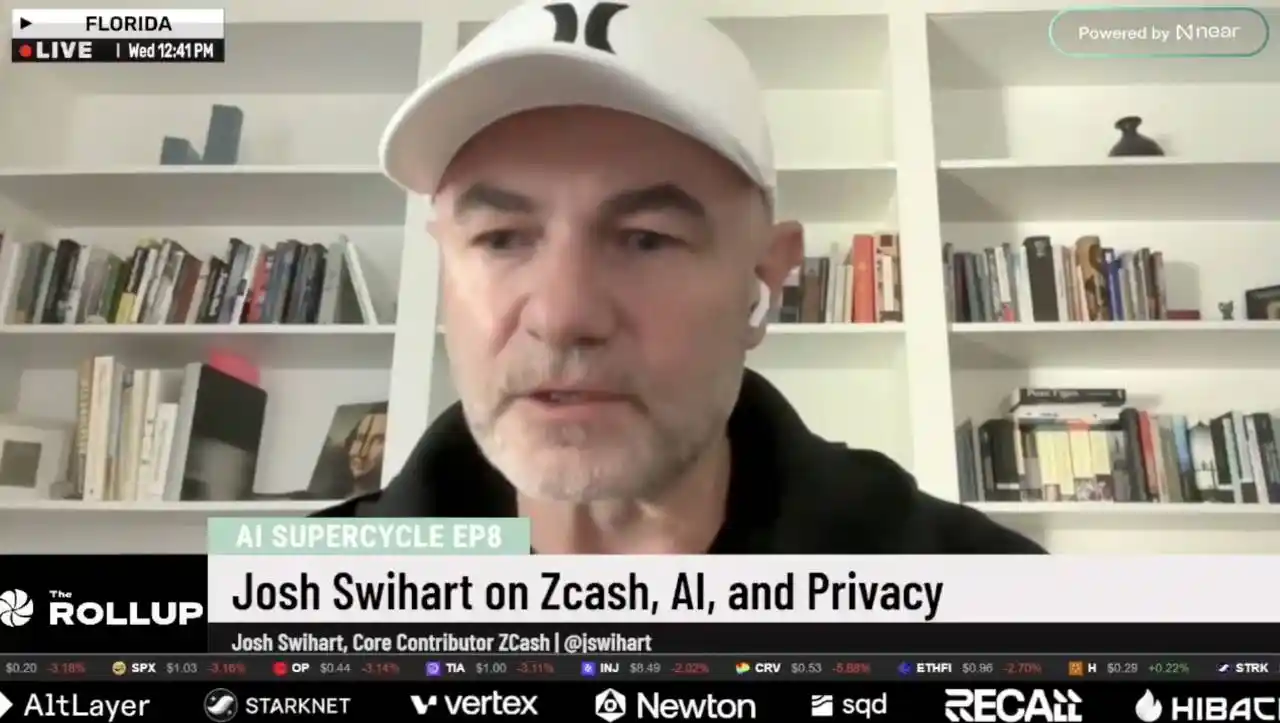
The launch of Zashi greatly improved the Zcash user experience. It provides a smooth interface comparable to popular EVM wallets, supports security features such as viewing keys and hardware wallet integration, and even plans to enable shielded watch-only and delegation features after launch. More importantly, Zashi is designed specifically for ZEC shielded transactions, meaning all tx sent on Zashi are private by default. If users receive transparent ZEC, the wallet requires you to shield it before spending. In addition, Zashi supports single-address multi-pool support for all different pools (Sprout, Sapling, Orchard), meaning users can easily migrate funds from different pools.
This is a huge change compared to a few years ago, when using Zcash privately required multiple dedicated software products. Due to these breakthroughs in user experience, shielded pool usage has grown parabolically, indicating that many users do choose privacy when a convenient option is available.
By making private transactions simple, just a few taps, and abstracting away technical complexity, these wallets have driven adoption among less tech-savvy users. Improved wallet user experience is considered the main driver of recent ZCash growth.
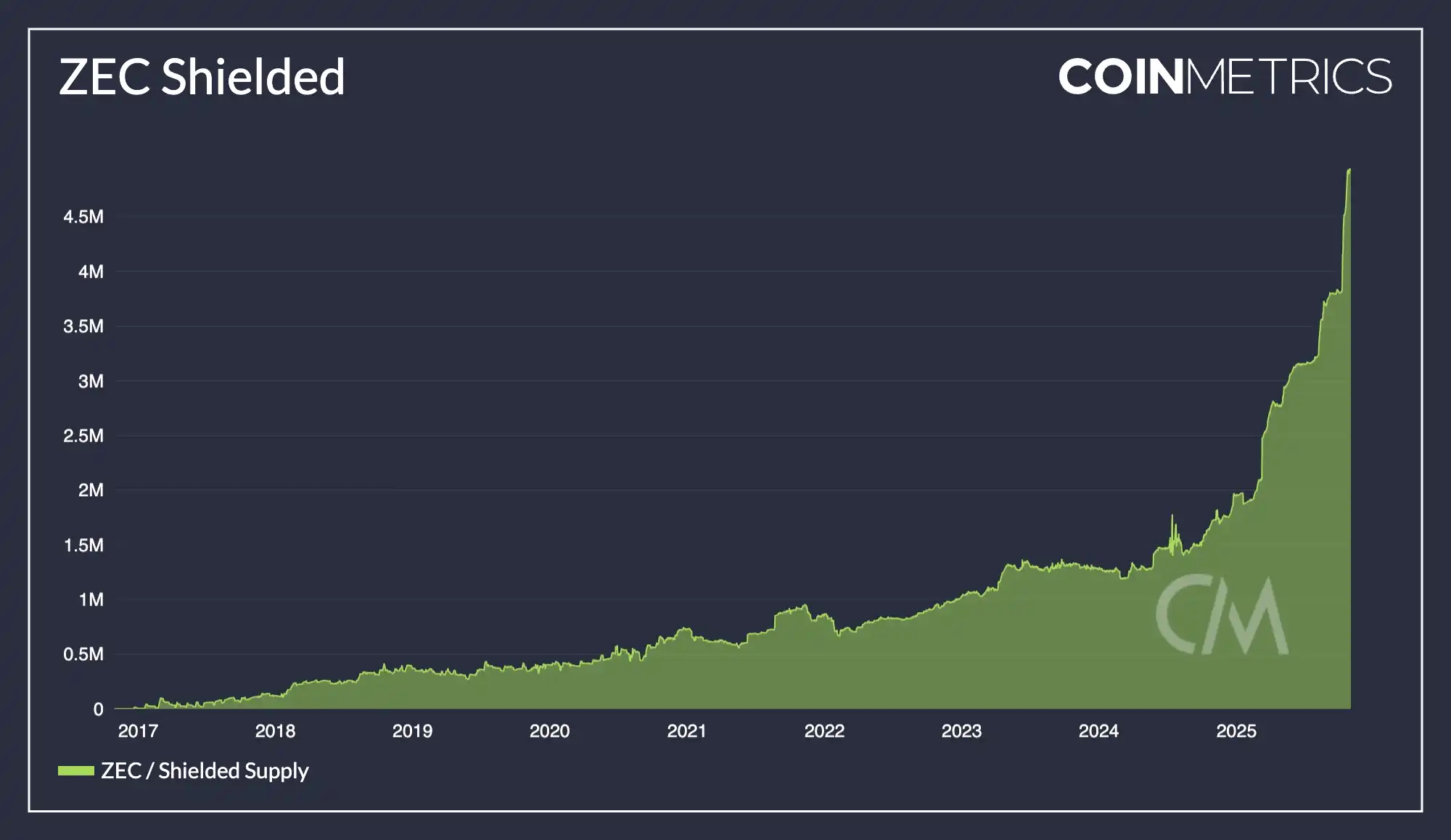
One of the most obvious signs of Zashi's contribution to Zcash ecosystem momentum is the explosive growth of on-chain shielded usage. As of Q4 2025, over 4.5 million ZEC are stored in shielded addresses, accounting for about 28% of total supply. This is a record high, compared to just 5% a few years ago. The chart above illustrates how the shielded pool began its parabolic growth around 2024, coinciding directly with Zashi's launch.
This means more ZEC is entering Zcash's encrypted pool, which in turn strengthens privacy protection for everyone on the network (a larger anonymity set). In practice, this also tightens circulating liquidity (since shielded funds are harder to track and are often held long-term for privacy), which positively impacts price dynamics.
Introduction of NEAR Intents - Crosspay
Zashi's CrossPay also acts as a mass onboarding mechanism for Zcash, fundamentally enabling interoperability for the Zcash ecosystem.
Crosspay is a cross-chain bridging/exchange solution that leverages NEAR Intents, allowing users to swap in or out of ZEC from another chain while maintaining privacy; Zashi also leverages NEAR to integrate decentralized off-ramps, allowing users to swap from ZEC to another chain (or to fiat gateways) without revealing their ZEC address—completely eliminating the need for CEX. This has driven a recent influx of capital and users into the ZEC ecosystem.
NEAR Intents is an on-chain abstraction protocol: users (or agents) specify what they want (e.g., "swap BTC→ZEC" or "pay 50 USDC to this address"), and a decentralized network of solvers competes to execute cross-chain; users only need to sign one approval. It hides bridge/DEX hops and the best price/liquidity route.
· Users request "swap X → ZEC" or "pay Y USDC on Z chain".
· NEAR Intents solvers compete and return the best quote.
· Users approve once in Zashi; solvers execute the cross-chain route; ZEC is shielded or the recipient receives the exact token.
USDC and USDT amounts are excluded from this sample; currently, ZEC NEAR Intents account for over 30% of total NEAR Intents volume.

Overall, we can infer that the integration of Zashi and Crosspay is also one of the main drivers of market share growth, with the magnitude of ZEC NEAR Intents increasing sharply from September 2025, which is exactly when Crosspay was launched.

The New Importance of Dual Transaction Type Privacy—A Story
As governments and regulators push for surveillance measures (from stricter KYC/AML to traceable central bank digital currencies), the cypherpunk spirit is back in the spotlight. Zcash offers a hedge for those concerned about these trends: an encrypted, unmonitorable form of money.
"They only pay attention to numbers going up, but don't notice freedom going down."
As mainstream crypto users become aware of privacy erosion (e.g., Tornado Cash and other mixers being blacklisted), many are looking for on-chain privacy alternatives. Zcash stands out as a battle-tested L1 with stronger privacy protection than mixer protocols (reportedly, Zcash is used more widely than Tornado Cash).
In short, the rise of the "freedom narrative" has shaped Zcash as a key asset for maintaining financial freedom—a narrative that resonates with both ideological investors and those simply seeking a hedge against "Big Brother."
Post-Halving Supply Dynamics
Zcash's second halving (November 2024) greatly reduced its new coin issuance, and we are now seeing its effects. Block rewards dropped from 3.125 ZEC to 1.5625 ZEC, and the annual inflation rate halved. Historically, Bitcoin's price did not consistently exceed $1,000 until after its second halving—after which Bitcoin's price rose parabolically. Zcash's supply curve is identical to Bitcoin's, just shifted by a few years, and it has just crossed the same milestone.
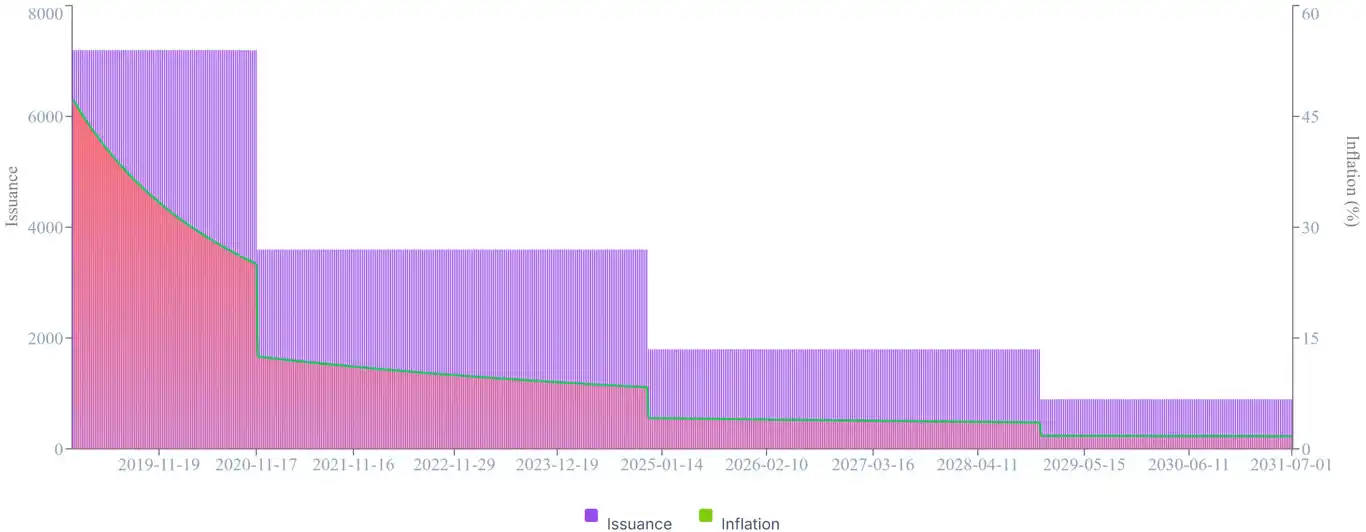
▲ ZEC USD issuance and inflation schedule
While demand is rising, circulating supply is tightening—this is a classic supply-demand squeeze. Investors speculate that after the "suspense" of high inflation disappears, ZEC may follow Bitcoin's early trajectory. In fact, in Q4 2025, ZEC's market performance has already surpassed most major coins. Some of this is just market timing, but fundamentally, Zcash's tokenomics are becoming more attractive as it matures: it has a fixed cap, decreasing emissions, and the end of miner rewards is approaching, similar to Bitcoin's development path.
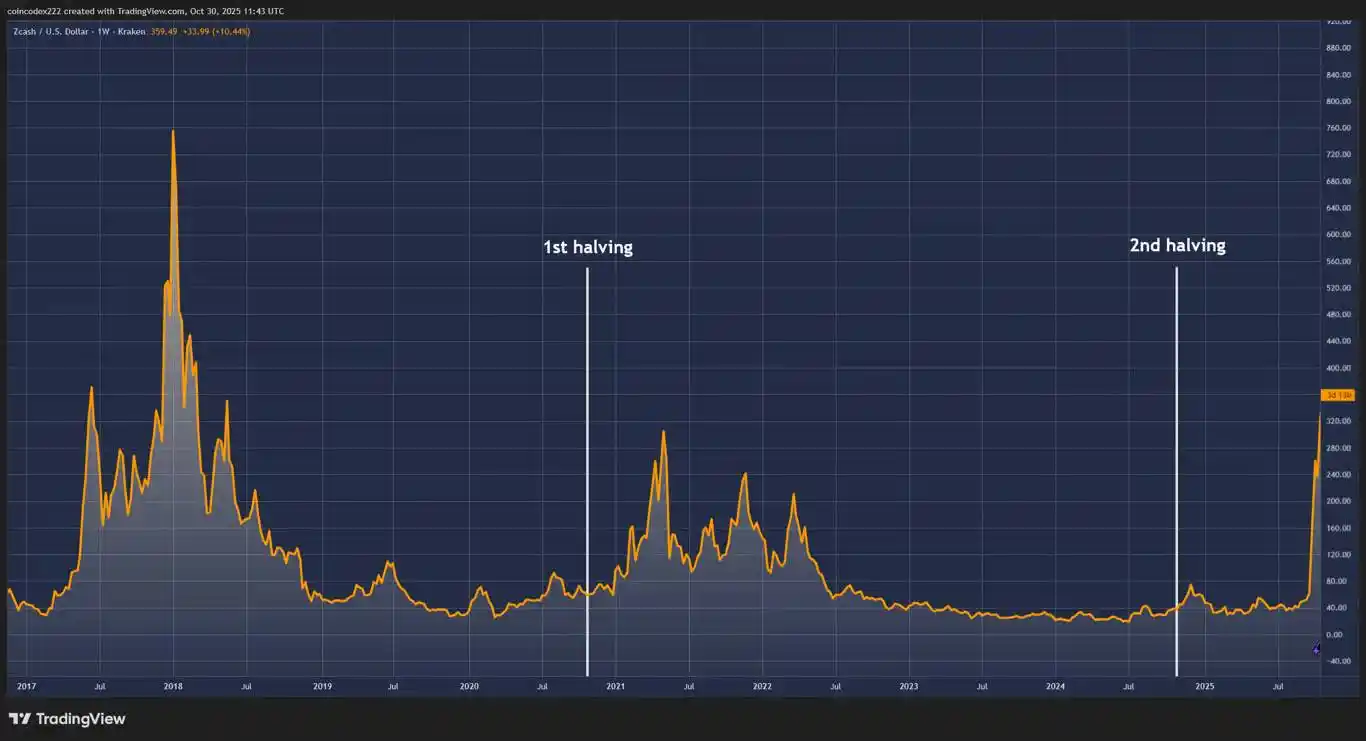
▲ ZEC USD price and halving schedule
The halving narrative—even if misunderstood by some traders (rumors of a 2025 halving are incorrect)—still draws attention to the Zcash story.
Disclaimer: The content of this article solely reflects the author's opinion and does not represent the platform in any capacity. This article is not intended to serve as a reference for making investment decisions.
You may also like
Bitcoin price gets $92K target as new buyers enter 'capitulation' mode
Full statement from the Reserve Bank of Australia: Interest rates remain unchanged, inflation expectations raised
The committee believes that caution should be maintained, and that outlook assessments should be continuously updated as data changes. There remains a high level of concern regarding the uncertainty of the outlook, regardless of its direction.

